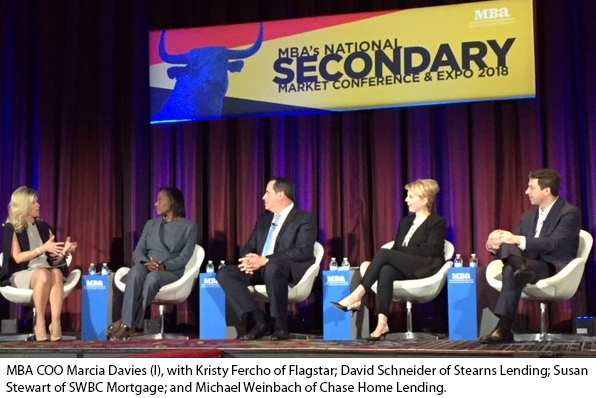
Secondary Markets: Executive Perspectives
NEW YORK–The mortgage industry continues to evolve as it adapts to the post-crisis regulatory environment, emerging technologies and a profound shift in market demographics.
Meanwhile, major public policy issues, such as housing finance reform remain unresolved, causing some mortgage investors to stay on the sidelines.
 A panel executives here at the Mortgage Bankers Association’s National Secondary Market Conference & Expo discussed how they have adapted to changing market conditions–and how they see the market evolving.
A panel executives here at the Mortgage Bankers Association’s National Secondary Market Conference & Expo discussed how they have adapted to changing market conditions–and how they see the market evolving.
“The environment for doing business is really tough,” noted MBA Chief Operating Officer Marcia M. Davies. “Rates are going up and margins are tightening.”
For example, Davies noted, a number of banks have shifted away from FHA lending over the years; last year, Wells Fargo ranked 35th among FHA lenders, Chase Home Lending ranked 84th.
“Our mortgage business is part of the bigger Chase family,” said Mike Weinbach, CEO of Chase Home Lending, New York. “The biggest issues are overly broad certifications that create risks and penalties…I am quite hopeful that the current administration will make some necessary changes and create a better atmosphere for FHA lending.”
“There’s really no benefit if the bigger banks aren’t participating in FHA lending,” said Susan T. Stewart, CEO of SWBC Mortgage, San Antonio, Texas.
“We’re one of the few banks that still operates across all channels,” said Kristy Fercho, President of Mortgage Banking with Flagstar Bank FSB, Troy, Mich. “There are concerns about the cost of servicing FHA loans and the potential that this could be the next crisis.”
“It’s a brutally competitive market right now,” Weinbach said. “And typically what happens in this situation is a shake-out.”
“There’s overcapacity in the market right now,” Fercho said. “And until the market shifts, we’re going to be in an extremely competitive market.”
Affordable housing remains a problem as well, Stewart said. “There aren’t a lot of vacant lots our there right now,” she said. “So there are a lot of costs associated with finding land. And then there’s the labor shortage, which also drives up costs. And the cost of supplies has also gone up exponentially, which adds to the problem because there are still a lot of people who want to get into homeownership. It’s going to be a challenge for all of us to meet that demand and meet it affordably.”
“Historically, the banks have done a pretty good job of partnering with non-profits and private businesses,” said David C. Schneider, AMP, CEO of Stearns Lending Inc., Santa Ana, Calif. “We’re going to have to develop more of these partnerships to identify more opportunities to create housing.”
Technology is another area for improvement and innovation. “Most mortgage bankers aren’t very good at using the data they have,” Schneider said. “We’re looking at where we establish new markets based on data, instead of who we know and where we know them. There is a benefit to taking a deep look at data and how to best use it.”
Evolving technology has also caused bankers to look at their entire model. “We’ve seen an evolution to Fintech 2.0, taking a vertical industry and taking a deep look at how it can do business better,” Weinbach said.
“Companies like Amazon and Google have forced all of us to look at the customer service model,” Fercho said. “We’re looking at how we take technology and our knowledge of the borrower within our data and seeing how we can better serve them…how we capture the consumer is going to define us, not only in how we serve them but in how we compete.”
Weinbach said private capital remains an issue in the secondary mortgage market, although he and other panelists agreed the market is improving. “There’s an awful amount of new regulation that has inhibited the market,” he said. “And QM [the Qualified Mortgage] was intended to spur private capital but in reality it has had the opposite effect.”
Fercho said private capital is coming back into the market, albeit slowly. “There’s still some skepticism about the quality of the non-QM, but we have to start changing the way we talk about it and work on educating potential private capital players so they can see how the markets perform…it’s a big opportunity.”
“There isn’t a shortage of capital; there’s a shortage of confidence in the system,” Schnieder said. “We need some consolidation to see it come back, and there’s lots of reasons to be confident.”
Looking forward, Fercho said Flagstar is targeting the next generation of borrowers, defining them as “independent strivers” who have “unique needs that don’t necessarily fit traditional boxes.
“Adjusting to new demographics is not about forcing them into your box, but meeting them where they are,” Fercho said. “We have to be able to line up our processes and technologies to follow them.”
“If we take out the speed bumps, we’ll serve our customers better and we will become more efficient,” Stewart added. “We are in a business that is ripe and ready for disruption. The fact that we are getting pushed by the current environment is a positive thing and it’s great that the industry is being pushed.”
“We have to continually raise the bar,” Weinbach said. “We have to make the process of getting a mortgage as easy as possible–not by raising the credit box, but by improving the efficiency.”
